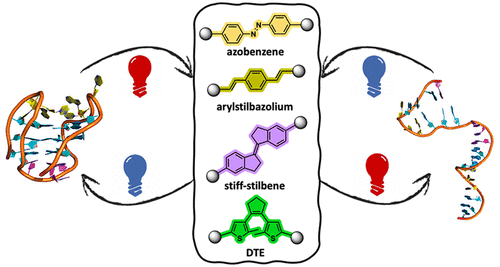Our official English website, www.x-mol.net, welcomes your feedback! (Note: you will need to create a separate account there.)
Photoresponsive Control of G-Quadruplex DNA Systems
JACS Au Pub Date : 2021-09-07 , DOI: 10.1021/jacsau.1c00283 Javier Ramos-Soriano 1 , M Carmen Galan 1
JACS Au Pub Date : 2021-09-07 , DOI: 10.1021/jacsau.1c00283 Javier Ramos-Soriano 1 , M Carmen Galan 1
Affiliation

|
G-quadruplex (G4) oligonucleotide secondary structures have recently attracted significant attention as therapeutic targets owing to their occurrence in human oncogene promoter sequences and the genome of pathogenic organisms. G4s also demonstrate interesting catalytic activities in their own right, as well as the ability to act as scaffolds for the development of DNA-based materials and nanodevices. Owing to this diverse range of opportunities to exploit G4 in a variety of applications, several strategies to control G4 structure and function have emerged. Interrogating the role of G4s in biology requires the delivery of small-molecule ligands that promote its formation under physiological conditions, while exploiting G4 in the development of responsive nanodevices is normally achieved by the addition and sequestration of the metal ions required for the stabilization of the folded structure. Although these strategies prove successful, neither allows the system in question to be controlled externally. Meanwhile, light has proven to be an attractive means for the control of DNA-based systems as it is noninvasive, can be delivered with high spatiotemporal precision, and is orthogonal to many chemical and biological processes. A plethora of photoresponsive DNA systems have been reported to date; however, the vast majority deploy photoreactive moieties to control the stability and assembly of duplex DNA hybrids. Despite the unique opportunities afforded by the regulation of G-quadruplex formation in biology, catalysis, and nanotechnology, comparatively little attention has been devoted to the design of photoresponsive G4-based systems. In this Perspective, we consider the potential of photoresponsive G4 assemblies and examine the strategies that may be used to engineer these systems toward a variety of applications. Through an overview of the main developments in the field to date, we highlight recent progress made toward this exciting goal and the emerging opportunities that remain ripe for further exploration in the coming years.
中文翻译:

G-四链体 DNA 系统的光响应控制
G-四链体 (G4) 寡核苷酸二级结构由于它们出现在人类致癌基因启动子序列和病原生物的基因组中,最近作为治疗靶点受到了极大的关注。G4s 本身也展示了有趣的催化活性,以及作为开发基于 DNA 的材料和纳米设备的支架的能力。由于在各种应用中利用 G4 的机会多种多样,因此出现了几种控制 G4 结构和功能的策略。研究 G4s 在生物学中的作用需要传递小分子配体,以促进其在生理条件下的形成,而在响应性纳米器件的开发中利用 G4 通常是通过添加和螯合稳定折叠结构所需的金属离子来实现的。尽管这些策略被证明是成功的,但它们都不允许从外部控制所讨论的系统。同时,光已被证明是控制基于 DNA 的系统的一种有吸引力的手段,因为它是非侵入性的,可以以高时空精度传递,并且与许多化学和生物过程正交。迄今为止,已经报道了大量的光响应 DNA 系统。然而,绝大多数采用光反应性部分来控制双链 DNA 杂交体的稳定性和组装。尽管生物学、催化和纳米技术中 G-四链体形成的调控提供了独特的机会,相对较少的注意力集中在基于光响应 G4 的系统的设计上。在这个视角中,我们考虑了光响应 G4 组件的潜力,并研究了可用于将这些系统设计为各种应用的策略。通过对迄今为止该领域主要发展的概述,我们重点介绍了在实现这一令人兴奋的目标方面取得的最新进展以及未来几年进一步探索的新机遇。
更新日期:2021-10-25
中文翻译:

G-四链体 DNA 系统的光响应控制
G-四链体 (G4) 寡核苷酸二级结构由于它们出现在人类致癌基因启动子序列和病原生物的基因组中,最近作为治疗靶点受到了极大的关注。G4s 本身也展示了有趣的催化活性,以及作为开发基于 DNA 的材料和纳米设备的支架的能力。由于在各种应用中利用 G4 的机会多种多样,因此出现了几种控制 G4 结构和功能的策略。研究 G4s 在生物学中的作用需要传递小分子配体,以促进其在生理条件下的形成,而在响应性纳米器件的开发中利用 G4 通常是通过添加和螯合稳定折叠结构所需的金属离子来实现的。尽管这些策略被证明是成功的,但它们都不允许从外部控制所讨论的系统。同时,光已被证明是控制基于 DNA 的系统的一种有吸引力的手段,因为它是非侵入性的,可以以高时空精度传递,并且与许多化学和生物过程正交。迄今为止,已经报道了大量的光响应 DNA 系统。然而,绝大多数采用光反应性部分来控制双链 DNA 杂交体的稳定性和组装。尽管生物学、催化和纳米技术中 G-四链体形成的调控提供了独特的机会,相对较少的注意力集中在基于光响应 G4 的系统的设计上。在这个视角中,我们考虑了光响应 G4 组件的潜力,并研究了可用于将这些系统设计为各种应用的策略。通过对迄今为止该领域主要发展的概述,我们重点介绍了在实现这一令人兴奋的目标方面取得的最新进展以及未来几年进一步探索的新机遇。



























 京公网安备 11010802027423号
京公网安备 11010802027423号